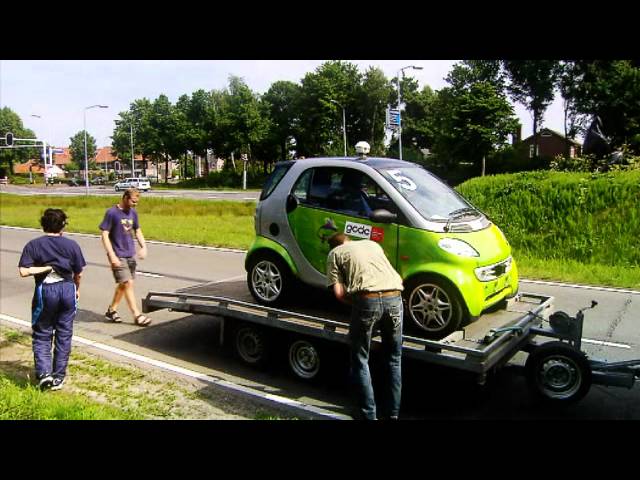EU Project Aims to Get Driverless Vehicles Talking
I-GAME’s focus is on cooperative solutions and the scenarios for next year’s competition during Dutch Technology Week have been selected to highlight situations where cooperation is superior to autonomy.
July 13, 2015

BRUSSELS – Driverless cars and trucks will be on the road in two to 10 years, depending on whose forecast you believe. And with about 90% of auto accidents attributable to human error, this sounds like the perfect solution.
However, to avoid collisions, driverless vehicles would need to communicate with each other and a European Union-funded research project running through October 2016 aims to ensure just that.
The Interoperable Grand Cooperative Driving Challenge AutoMation Experience, or I-GAME, is a 2-step project in which teams from universities and industry will compete against each other, first in designing and implementing the most effective cooperative-vehicle system possible, then testing them in front of road-safety authorities and standardization bodies at an international competition in June 2016.
One project aim is to develop a standard to ensure interoperability. I-GAME is not working from scratch, but using the European Telecommunications Standards Institute’s Cooperative Intelligent Transport Systems (C-ITS) norm as a base. But C-ITS mostly is designed to tell motorists about road and vehicle conditions, meaning the I-GAME team had to design add-ons.
Jonas Didoff, senior project manager for Sweden’s Viktoria Swedish ICT, one of the partners in the project along with TNO and TU/e, both of the Netherlands, and Spain’s IDIADA, stresses that the multi-vendor approach is key to I-GAME.
“So far most projects involving cooperative vehicles have been based on one vendor and one system solution,” Didoff tells WardsAuto. “These projects were necessary in the beginning to verify the technology. Now we know the technology is at hand. So for the future it is not realistic that one system will dominate the control and development of vehicle interaction.”
One issue I-GAME does not cover is security and protecting vehicles from hackers, but the team is monitoring developments in the field. “I think the issue of system integrity must be solved – together with other issues,” Didoff says, notably infrastructure and whether there should be special lanes and traffic lights as well as legal questions such as who is responsible in case of an accident.
I-GAME researchers insist they are not in competition with others developing automated systems, notably Apple and Google, and have challenged the tech companies to compete in next year’s GCDC. However, Didoff says the two have yet to show interest: “They are more into the autonomous side is my guess, but it would be nice to have them joining the collaborative side. “One does not exclude the other but a cooperative vehicle is one that ‘talks’ to others and has the ability to jointly solve an issue through collaboration, while an autonomous is one that has on-board systems to cope with (almost) all situations by itself.”
I-GAME’s focus is on cooperative solutions and the scenarios for the GCDC competition during Dutch Technology Week in June 2016 have been selected to highlight situations where cooperation is superior to autonomy. But, Didoff notes: “This is not a competition between two ‘schools.’ Personally I believe that the ideal situation is collaborative vehicles when possible and autonomous when you go out on your own – the last mile.”
Dates for Dutch Technology Week will be announced July 9.
Into the Mix With Conventional Vehicles
The competition will involve two main scenarios starting with two platoons merging on a highway before roadworks. This must be done with minimum deceleration, keeping safe distances and as late as possible to optimize road space.
The second involves an intersection onto a busy road with a mix of cooperative and regular vehicles coming from both directions. Competitors will have to cooperate to yield and allow a vehicle onto the busy road without stopping. Vehicles on the busy road will act as pace cars slowing traffic to allow the oncoming vehicle to merge safely.
“These type of scenarios would not be possible with autonomous vehicles – at least not with the same efficiency,” Didoff says.
Participation will be mandatory in a third demonstration scenario he says is “still kept a bit in the dark – but will involve an ambulance in a dense traffic situation.”
Trucks as well as cars will take part in next year’s challenge. “There are several ongoing platooning projects and a lot of them involving trucks – as this is where the business incentives are highest,” Didoff says. In North America a driverless truck corridor is planned to run from Mexico up to Manitoba, Canada, for example.
The challenge is international and although final registrations open later this summer, the “list of interest” includes teams from Canada, China, India, Japan, South Korea, Mexico, Vietnam and the U.S. EU teams also include Canadian and U.S. participants.
Two protocols, dealing with vehicle-to-vehicle interaction, when merging and at intersections are ready to distribute to the teams, but Didoff notes: “This may be subject to modification as we start more interaction with the teams in the fall. We also have an online testing tool where teams can test their communication on the Internet with other teams or with their own (fake) vehicles.” I-GAME partners also are building a dummy vehicle for the project to test, for example, the protocols and judging criteria for the challenge.
“Automation is all about collaboration – and this is the focus of I-GAME,” he says. “It targets individual development of technology judged on the capability to collaborate with others. This is a more realistic situation for future development.”
About the Author
You May Also Like